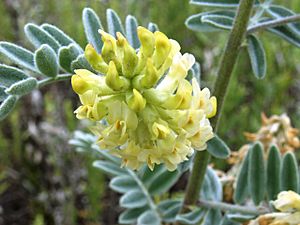Astragalus pycnostachyus var. lanosissimus facts for kids
Quick facts for kids Astragalus pycnostachyus var. lanosissimus |
|
|---|---|
 |
|
| Scientific classification |
|
| Kingdom: | Plantae |
| Clade: | Tracheophytes |
| Clade: | Angiosperms |
| Clade: | Eudicots |
| Clade: | Rosids |
| Order: | Fabales |
| Family: | Fabaceae |
| Genus: | Astragalus |
| Species: | |
| Varietas: |
A. p. var. lanosissimus
|
| Trinomial name | |
| Astragalus pycnostachyus var. lanosissimus (Rydb.) Munz & McBurney ex Munz
|
|
| Synonyms | |
|
Phaca lanosissima Rydb. |
|
The Ventura marsh milk-vetch (Astragalus pycnostachyus var. lanosissimus) is a special type of plant. It's a short-lived plant that comes back each year. This plant belongs to the pea family, called Fabaceae.
What it Looks Like
The Ventura marsh milk-vetch has many small, light yellow flowers grouped together. Its leaves are silvery-white and made up of many smaller leaflets. This plant usually blooms from June all the way through October.
In 2001, the U.S. Fish and Wildlife Service officially listed this plant as endangered. This means it is at a very high risk of disappearing forever.
Where it Lives
Long ago, the Ventura marsh milk-vetch grew in sandy areas behind sand dunes and in coastal meadows. It also lived near salty coastal marshes. These areas were found from Ventura County to Orange County in California. Over the last 100 years, people knew of seven places where this plant used to grow.
For a while, people thought this plant had completely disappeared. It was rediscovered in June 1997 by a biologist from the USFWS. This happened at a place where new buildings were planned. Before this, it had only been seen twice in the past century.
Today, only one group of these plants is known to exist. It is located near the city of Oxnard in Ventura County. This small area is less than 0.6 acres, or about 2854 square feet. The plants grow on disturbed coastal areas that were once used differently.
Helping the Plant Survive
Since 1997, between 192 and 374 individual Ventura marsh milk-vetch plants have been counted at this site. Most of these are young plants or seedlings. Many coastal wetland habitats in Southern California have been lost or damaged. About 80-90% of these important areas are gone. Scientists still need to learn a lot about what this plant needs to grow well.
The only known group of Ventura marsh milk-vetch plants faces several dangers. Animals might eat them, and their living space could be changed. They might also be harmed if the water levels change. Non-native plants, which are not from this area, can also compete with them for space and resources.
The California Department of Fish and Game (now called the California Department of Fish and Wildlife - CDFW) is working hard to protect this plant. They are working with the landowner, the USFWS, and other groups. Their goal is to find new places where the Ventura marsh milk-vetch can be planted to help it recover. Scientists are also studying the plant in greenhouses. They are doing research to understand more about what the plant needs to survive and thrive.
In 1998, the California Native Plant Society asked the California Fish and Game Commission to list the Ventura Marsh Milkvetch as an endangered species. This request was approved. The plant was officially listed as endangered by California in 2000. Then, in 2001, the USFWS also listed it as endangered under federal law. This means it has strong legal protection.

